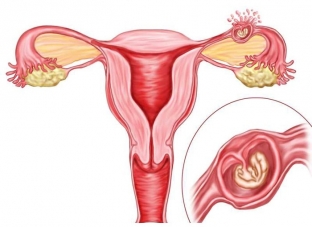Ectopic pregnancy is one of the most dangerous conditions in gynecology, since such a pregnancy is often terminated early, causing a clinical picture of an acute abdomen and ultimately leading to infertility. Ectopic pregnancy in almost 99% of cases develops in the lumen of the fallopian tubes, while it can occur in three forms: progressive tubal pregnancy, tubal abortion and rupture of the fallopian tube. A feature of tubal pregnancy is that in the first two cases, the symptoms of the pathology are not pronounced, so it is necessary to use different methods for diagnosing ectopic pregnancy.
Laboratory and instrumental methods for diagnosing ectopic pregnancy
In many cases, the symptoms of tubal pregnancy may be completely absent or manifest slightly. At the same time, such a pathological pregnancy can often lead to impaired reproductive function up to the occurrence of infertility. That is why the diagnosis of ectopic pregnancy should be as early and informative as possible, which is necessary for the timely provision of effective medical care. To date, various laboratory and instrumental research methods are used to diagnose ectopic pregnancy. An important point is also the competent collection of the patient's history.
Diagnosis of ectopic pregnancy:
- methods for diagnosing advanced tubal pregnancy;
- diagnosis of ectopic pregnancy: tubal abortion;
- methods for diagnosing a ruptured fallopian tube.
Methods for diagnosing advanced tubal pregnancy
Diagnosing an ectopic pregnancy in the development of a progressive tubal pregnancy is quite difficult, since there are no characteristic symptoms of the pathology. When bimanual gynecological examination, there is a discrepancy between the size of the uterus and the delay in menstruation. Palpation in the area of the uterine appendages can be determined spindle-shaped formation, which has a soft or elastic texture, significantly painful on palpation. But if the gestational age is insignificant, the fallopian tube may be unchanged. There are no signs of pregnancy in this case, instrumental research methods help to visualize the fetal egg inside the fallopian tube.

Diagnosis of ectopic pregnancy: tubal abortion
Diagnosis of tubal abortion is also difficult and is based on the following data:
- History features: delayed menstruation can range from several days to 2-3 months;
- clinical picture: paroxysmal pain, coinciding in time with bleeding from the genital tract, resembling "coffee grounds";
- vaginal examination: slight softening and enlargement of the uterine body, soreness and pastosity of the uterine appendages, tension of the posterior vaginal fornix;
- general blood test: decrease in hemoglobin level, hypochromic anemia, shift of the leukocyte formula to the left;
- chorionic gonadotropin is determined in the blood;
- Ultrasound helps clarify the diagnosis of tubal abortion.
Methods for diagnosing a ruptured fallopian tube
Rupture of the fallopian tube is easy enough to diagnose, since the clinical picture of the disease is quite characteristic. The pain syndrome in such patients occurs abruptly against the background of complete well-being, the pain has a characteristic irradiation, tenesmus and loose stools often occur. Patients have pallor of the skin and mucous membranes, cold sweat and shortness of breath, they are lethargic and lethargic. Characteristic is a significant decrease in blood pressure: systolic pressure may be below 80 mm Hg. Palpation is determined by a sharp soreness of the abdomen, symptoms of irritation of the peritoneum, overhanging and soreness of the posterior fornix of the vagina. Laparoscopic examination helps not only to clarify the diagnosis, but also to determine the treatment regimen for the patient.






Add a comment